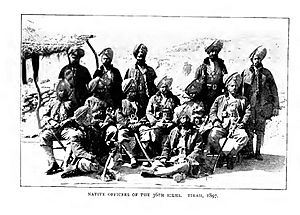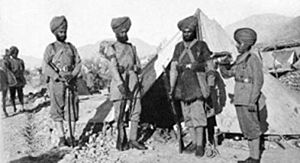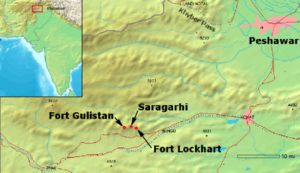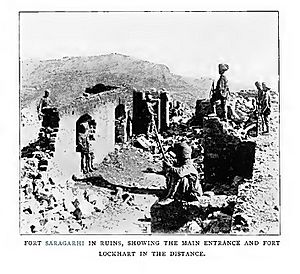Battle of Saragarhi facts for kids
Quick facts for kids Battle of Saragarhi |
|||||||
|---|---|---|---|---|---|---|---|
| Part of the Tirah Campaign | |||||||
 Depiction of the Battle of Saragarhi of the Tirah Campaign |
|||||||
|
|||||||
| Belligerents | |||||||
|
• |
|||||||
| Commanders and leaders | |||||||
| Strength | |||||||
| 21 | 10,000 to 12,000 | ||||||
| Casualties and losses | |||||||
| 21 dead | 450 (estimate) dead and wounded See Aftermath section |
||||||
The Battle of Saragarhi was an amazing "last stand" battle. This means a small group of soldiers fought bravely against a much larger enemy force, even when they knew they might not win. It happened before the Tirah Campaign between the British Raj (British rule in India) and Afghan tribesmen.
On 12 September 1897, about 10,000 to 12,000 Afghan tribesmen attacked a small outpost called Saragarhi. This outpost was important because it helped two larger British forts, Fort Gulistan and Fort Lockhart, talk to each other using signals.
The outpost was defended by only 21 brave soldiers, all of whom were Sikhs. They were led by Havildar Ishar Singh. Even though they were greatly outnumbered, they refused to give up. They fought until every last soldier was killed. The outpost was taken back by other British Indian soldiers two days later.
All 21 soldiers were given the Indian Order of Merit after they died. This was the highest award an Indian soldier could get at that time for being very brave. The Indian Army still remembers this battle every year on 12 September. They call it Saragarhi Day.
Contents
What Led to the Battle?
Saragarhi was a small village in a hilly area called the Samana Range. This area is in what is now Pakistan. In 1894, a special group of soldiers called the 36th Sikhs was formed. All of its soldiers were Jat Sikhs.
In 1897, five companies of the 36th Sikhs were sent to the northwest border of British India. This area was often restless, with local Pashtuns sometimes attacking British soldiers.
To help control the area, the British used a series of forts. Two important forts were Fort Lockhart and Fort Gulistan. They were a few miles apart. But they couldn't see each other. So, Saragarhi was built in the middle as a communication post. It had a small building with holes for shooting and a tower for sending signals.
In 1897, the Afghan tribes started a big uprising. Between August and September, Pashtun tribesmen tried many times to capture the forts. But the 36th Sikhs always pushed them back. On 3 and 9 September, Afridi tribesmen attacked Fort Gulistan. These attacks were also stopped. After one of these attacks, more soldiers were sent to Saragarhi. This made the total number of soldiers there 21.
The Battle of Saragarhi
We know a lot about the Battle of Saragarhi because a soldier named Sepoy Gurmukh Singh sent messages. He used a heliograph, which is a device that uses mirrors to flash sunlight signals. He sent messages to Colonel Haughton at Fort Lockhart as the battle happened.
- Around 9:00 AM, about 6,000 to 10,000 Afghan tribesmen arrived at Saragarhi.
- Sepoy Gurmukh Singh quickly signaled to Colonel Haughton that they were under attack.
- Colonel Haughton replied that he could not send help right away.
- The soldiers at Saragarhi decided to fight until the very end. They wanted to stop the enemy from reaching the main forts.
- Sepoy Bhagwan Singh was the first soldier to be killed. Naik Lal Singh was badly hurt.
- Naik Lal Singh and Sepoy Jiwa Singh bravely carried Bhagwan Singh's body back inside the post.
- The Afghans managed to break a part of the outpost wall.
- Colonel Haughton signaled back that he thought there were between 10,000 and 14,000 Pashtuns attacking.
- The Afghan leaders tried to get the soldiers to give up. They made promises to them.
- The Afghans tried twice to force open the main gate, but they failed.
- Later, they broke through the wall.
- Then, there was very fierce hand-to-hand fighting inside the post.
- Havildar Ishar Singh told his men to move back to an inner part of the post. He stayed behind to cover them. After the inner area was also broken into, all but one of the soldiers were killed. Many Pashtuns also died.
- Sepoy Gurmukh Singh, the signalman, was the last soldier left. His final message was to ask for permission to pick up his rifle. After getting permission, he put away his signaling device. He then held the door of his shed. It is said he killed 40 Afghans. The Pashtuns had to set fire to the post to kill him. As he was dying, Gurmukh Singh reportedly shouted the Sikh battle cry, "Bole So Nihal, Sat Sri Akal!"
The Brave Soldiers
Here are the names of the 21 Sikh soldiers who fought so bravely at Saragarhi:
- Havildar Ishar Singh (regimental number 165)
- Naik Lal Singh (332)
- Lance Naik Chanda Singh (546)
- Sepoy Sundar Singh (1321)
- Sepoy Ramm Singh (287)
- Sepoy Uttar Singh (492)
- Sepoy Sahib Singh (182)
- Sepoy Hira Singh (359)
- Sepoy Daya Singh (687)
- Sepoy Jivan Singh (760)
- Sepoy Bhola Singh (791)
- Sepoy Narayan Singh (834)
- Sepoy Gurmukh Singh (814)
- Sepoy Jivan Singh (871)
- Sepoy Gurmukh Singh (1733)
- Sepoy Ram Singh (163)
- Sepoy Bhagwan Singh (1257)
- Sepoy Bhagwan Singh (1265)
- Sepoy Buta Singh (1556)
- Sepoy Jivan Singh (1651)
- Sepoy Nand Singh (1221)
What Happened After?
After destroying Saragarhi, the Afghans tried to attack Fort Gulistan. But the brave fight at Saragarhi had delayed them for too long. Reinforcements arrived at Fort Gulistan on the night of 13–14 September, so the fort could not be captured.
The Pashtuns later said they lost about 180 fighters and many more were wounded in the battle against the 21 Sikh soldiers. When the relief party arrived, they saw about 600 bodies around the ruined post.
After the British took back Saragarhi, they used the burnt bricks to build a monument for the brave soldiers. They also built special Sikh temples, called gurdwaras, in Amritsar and Ferozepur to honor them.
Remembering the Heroes
Commemorative Tablet
A special tablet was put up to remember the soldiers. It says:
The Government of India put up this tablet to remember the twenty-one non-commissioned officers and men of the 36 Sikh Regiment. Their names are written below. This is a lasting record of the bravery shown by these brave soldiers. They died at their posts defending the fort of Saragarhi on 12 September 1897. They fought against huge numbers, showing their loyalty to their Queen Empress of India. They also kept up the Sikhs' reputation for amazing courage in battle.
Highest Awards
The 21 Sikh soldiers who died in the Battle of Saragarhi were from the Majha region of Punjab. They were given the Indian Order of Merit after their deaths. At that time, this was the highest award an Indian soldier could get for bravery. It was like the Victoria Cross for British soldiers. Today, it is similar to India's Param Vir Chakra.
Legacy and Saragarhi Day

The Battle of Saragarhi has become a very important story. It shows the bravery in Eastern military history, the British Empire's military history, and Sikh history. The modern Sikh Regiment of the Indian Army still celebrates the Battle of Saragarhi every year on 12 September. They call it their Regimental Battle Honours Day.
To honor the men, the British built two Saragarhi Gurdwaras (Sikh temples). One is in Amritsar, near the famous Golden Temple. The other is in Firozpur Cantonment, where most of the soldiers came from.
There is also an epic poem called "Khalsa Bahadur" that remembers the Sikhs who died at Saragarhi.
In Indian Schools
The Indian Armed Forces, especially the Indian Army, have wanted the story of this battle to be taught in Indian schools. They believe the bravery of these soldiers can inspire children. Since 2000, the battle has been taught in schools in Punjab.
The decision to include the battle story in school lessons was made after many people asked for it. The Sikh Regiment and groups of former soldiers wanted children to learn about this brave act. They felt the battle had many inspiring lessons for young people. It is said that when the British Parliament heard about the soldiers' bravery, they all stood up to honor them.
Saragarhi Day Celebrations
| Saragarhi Day | |
|---|---|
| Official name | Saragarhi Day |
| Observed by | India (also observed by Sikhs worldwide) |
| Type | national & international |
| Significance | Honors the 21 military Sikh soldiers who died at the Battle of Saragarhi |
| Observances | Parades, school history projects, government buildings |
| Date | 12 September (or nearest weekday) |
| Related to | Remembrance Day |
Saragarhi Day is a special day for Sikhs and the military. It is celebrated every year on 12 September to remember the Battle of Saragarhi. Sikh soldiers and people around the world celebrate this day. All parts of the Sikh Regiment celebrate Saragarhi Day as their Regimental Battle Honours Day.
Saragarhi Day in the UK
The story of Saragarhi has also been remembered in the United Kingdom. In 2002, Prince Charles (who is now King Charles III) opened an exhibition that included a section on Saragarhi.
The battle has been remembered each year in the UK by the British Armed Forces since 2013. Important leaders and generals have spoken about the bravery of Sikh soldiers, often mentioning Saragarhi.
In November 2020, the city of Wolverhampton approved plans for a 10-foot tall bronze statue. This statue honors the battle and is outside a Sikh temple in Wednesfield. The statue of Havildar Ishar Singh was paid for by donations from the local Sikh community. It was revealed on 12 September 2021.
See also
- Battle of Thermopylae
- Battle of Purandar
- Battle of Pavan Khind
- Tirah campaign
- Battle of Rezang La
- List of last stands





